Forestland Resource Dynamics in Hollow Frontiers of Sub-Saharan Africa: Empirical Insights from the Mungo Corridor of Cameroon
Abstract
1. Introduction
2. Study Area and Method
Data Collection
3. Results
Typology and Distribution of Non-Timber Forest Products (NTFPs) in the Mungo Corridor
“White-pepper is the dominant NTFPs here in Njombe-Penja. White-pepper is dominant because it has become the most domesticated NTFPs by the local population and private companies to include Plantation du Haute Penja (PHP)”.
“Individuals have domesticated white-pepper estimated on two hectares of land. PHP has domesticated white-pepper on very large-scale banana plantation. The increase in the price of white-pepper has intensified the domestication of white-pepper, making it the most dominant NTFPs here in Loum”.
“Eru is domesticated, though by a few. Eru used to be regarded just as every other NTFPs to include bushmeat which was only extracted from the forest. But, due to an increase in the demand and price of eru, and also the decrease in its availability due to forest cover, triggers the domestication of eru beside bitter-kola”.
“The dominant forest resource that here is bushmeat. There are occasions that I will go into the forest without the intention of hunting bushmeat, my dogs will hunt and kill more than four to five animals to include snakes, rat moles, porcupine, antelope, grass cutter, and giant frogs, without my intervention”.
4. Discussion
5. Conclusions
Author Contributions
Funding
Institutional Review Board Statement
Data Availability Statement
Conflicts of Interest
References
- Castella, J.-C.; Boissau, S.; Thanh, N.H.; Novosad, P. Impact of forestland allocation on land use in a mountainous province of Vietnam. Land Use Policy 2006, 23, 147–160. [Google Scholar] [CrossRef]
- WDI. World Development Indicators. 2016. Available online: https://data.worldbank.org/products/wdi (accessed on 10 January 2025).
- Franks, P.; Hou-Jones, X. Reconciling Forest Conservation with Food Production in Sub-Saharan Africa: Case Studies from Ethiopia, Ghana and Tanzania; IIED Research Report: London, UK, 2017; ISBN 978-1-78431-470-5. Available online: http://pubs.iied.org/17605IIED (accessed on 5 April 2025).
- Kissinger, G.; Herold, M.; De Sy, V. Drivers of Deforestation and Forest Degradation: A Synthesis Report for REDD+ Policymakers; Lexeme Consulting: Vancouver, BC, Canada, 2012. [Google Scholar]
- Kamga, A.; Kouamé, C.; Tchindjang, M.; Chagomoka, T.; Drescher, A.W. Environmental impacts from overuse of chemical fertilizers and pesticides amongst market gardening in Bamenda, Cameroon. Rev. Sci. Tech. Forêt Environ. Bassin Congo 2013, 1, 6–19. [Google Scholar]
- Mirkatouli, J.; Hosseini, A.; Neshat, A. Analysis of land use and land cover spatial pattern based on Markov chains modelling. City Territ. Arch. 2015, 2, 4. [Google Scholar] [CrossRef]
- Atangana, J.N.; Tchindjang, M.; Moulende, T.; Bene Bene, C.L. Evaluation Eenvironnementale de la Problématique de Bois de feu dans la vile de Garoua Nord Cameroun. Colloque SIFEE. 2010. Available online: http://www.sifee.org/Actes/actes_paris_2010/Communications/BLOC_4/S_4.1/3_NTSAMA_ATANGANA_TXT.pdf. (accessed on 15 March 2025).
- Tchindjang, M.; Amougou, J.A.; Abossolo, S.A.; Bessoh Bell, S. Challenges of climate change, landscape dynamics and environmental risks in Cameroon. In Landscape Evolution, Neotectonics and Quaternary Environmental Change in Southern Cameroon: Palaeoecology of Africa; Taylor and Francis: London, UK, 2012; Volume 31, Chapter 5; pp. 237–286. [Google Scholar]
- Forba, C.F.; Kimengsi, J.N. An Empirical Analysis of the Relationship between Plantation Development and Urbanisation in the Mungo Corridor of Cameroon. Greener J. Environ. Manag. Public Saf. 2015, 4, 1–8. [Google Scholar]
- Bongaarts, J.; Buetterner, J.; Heilig, G.; Pelletier, F. Has the AIDS epidemic peaked? Popul. Dev. Rev. 2008, 34, 199–244. [Google Scholar] [CrossRef]
- Busch, C.B.; Vance, C. The Diffusion of Cattle Ranching and Deforestation—Prospects for a Hol-low Frontier in Mexico’s Yucatán; Ruhr Economic Papers No.242; Rheinisch-Westfälisches Institut für Wirtschaftsforschung (RWI): Essen, Germany, 2011. [Google Scholar]
- Taylor, H.W. Sao Pailo’s hollow frontier. Rev. Geogr. 1973, 149–166. [Google Scholar]
- Kimengsi, N.J.; Nkongwibuen, A.L.; Assako, R.L.; Suiven, J.P.T.; Yemmafouo, A.; Mairomi, H.W. Hollow Frontier Dynamics and Land Resource Exploitation in the Mungo Landscape of Cameroon. Can. J. Trop. Geogr. Rev. Can. Géographie Trop. 2023, 9, 7–13. [Google Scholar]
- Sven, B.; Ulbe, B.; Mindi, S.; Vanhaute, E. Commodity frontier and global histories: The tasks ahead. J. Glob. Hist. 2021, 16, 466–469. [Google Scholar] [CrossRef] [PubMed]
- Ujjayant, C.; Herath, M.G. Forest Resources Extraction by Local Communities: A Comparative Dynamics Analysis; SSRN; FEEM: Milan, Italy, 2000. [Google Scholar] [CrossRef]
- Ibifubara, W.R.; Emem Okon, A.; Patrick Anthony, A. Overexploitation of Forest Resources and Its Impact on Environment: A Case Study of ITU Local Government Area of Akwa Ibom States. Int. J. Oper. Res. Manag. Soc. Sci. Educ. 2018, 4, 36–45. [Google Scholar]
- Nyongo, P.K.; Kimengsi, J.N. Socio-ecological outcomes of forest landscape mutations in the Congo Basin: Learning from Cameroon. Land 2025, 14, 1644. [Google Scholar] [CrossRef]


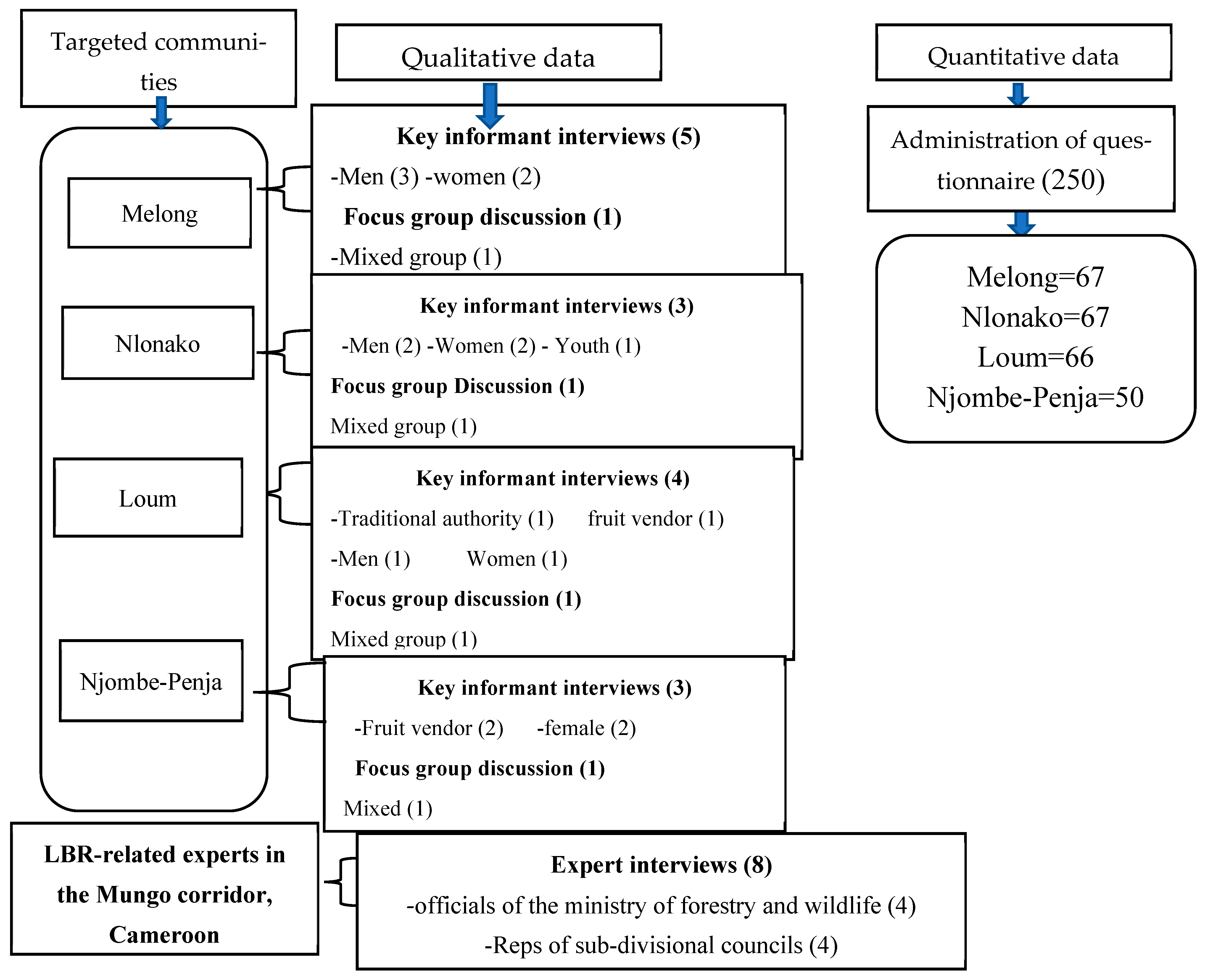

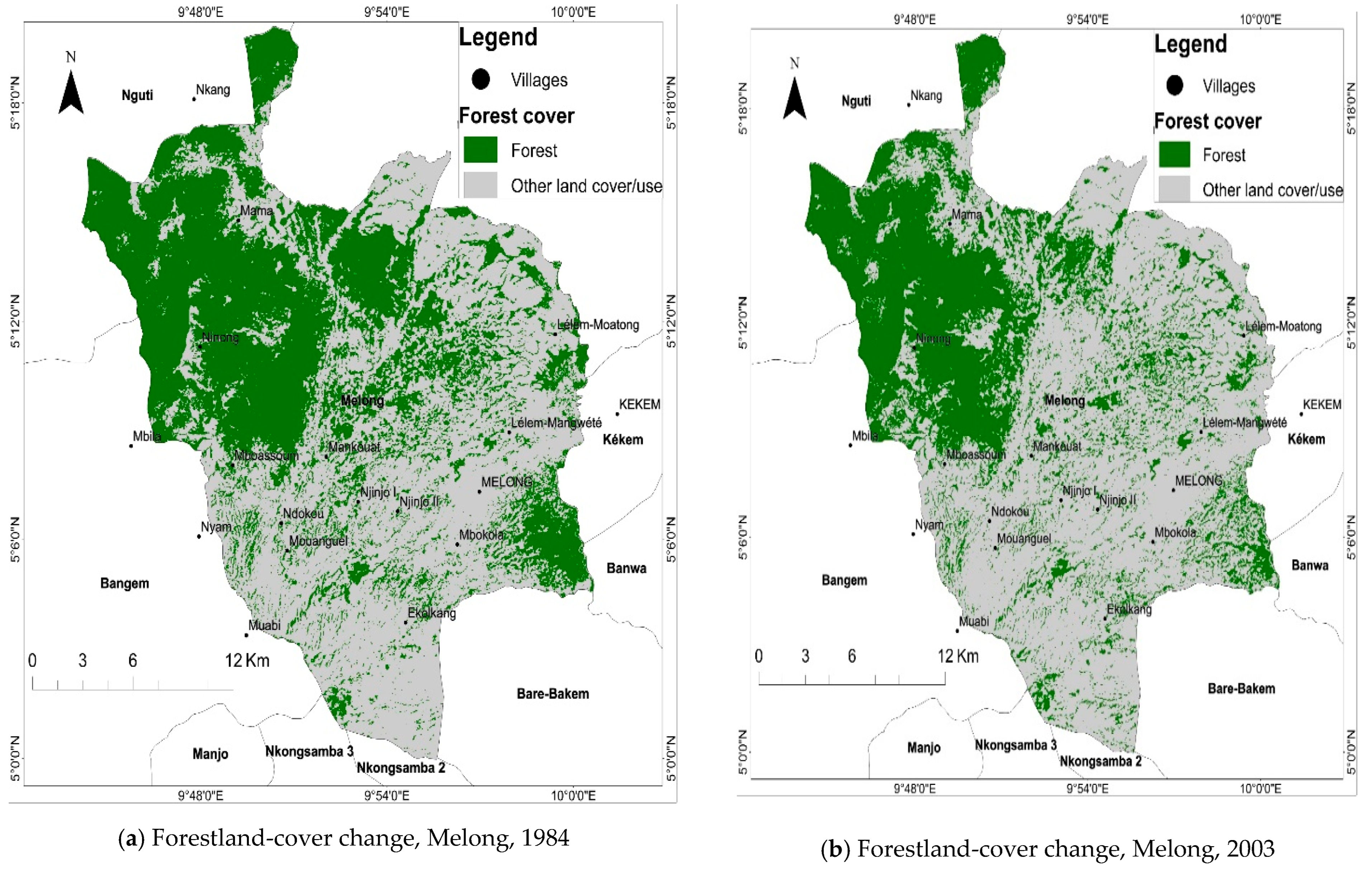

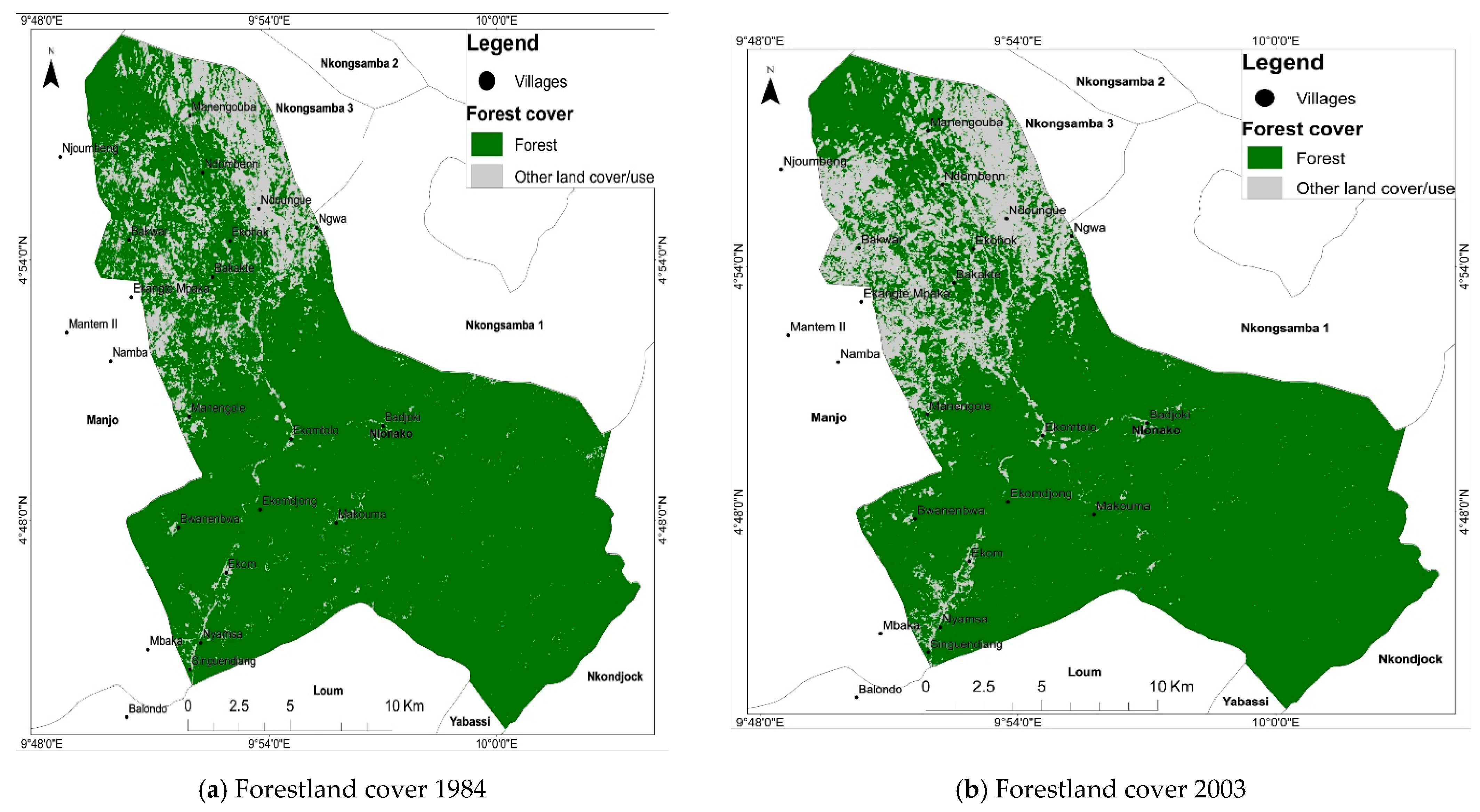
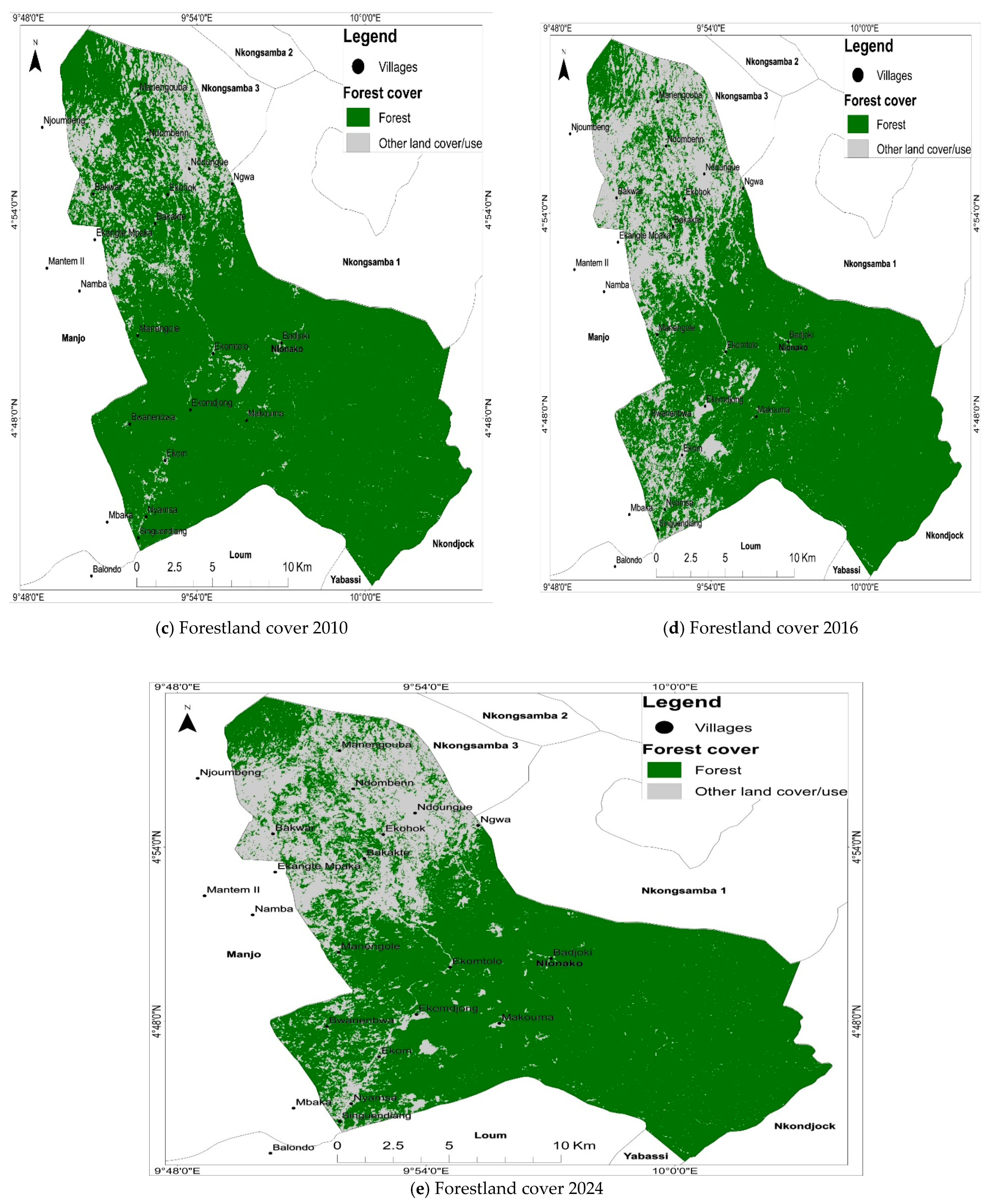

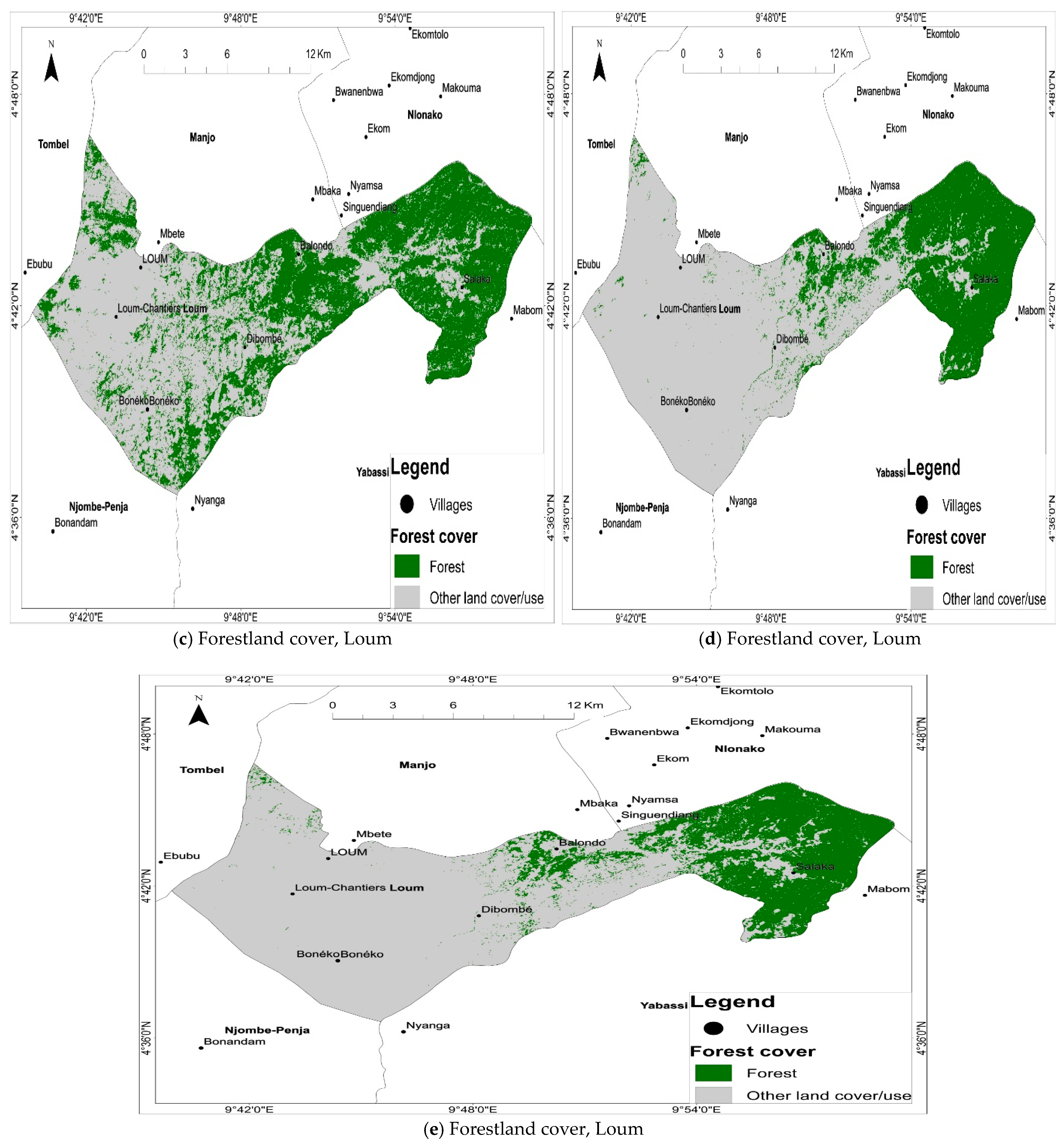
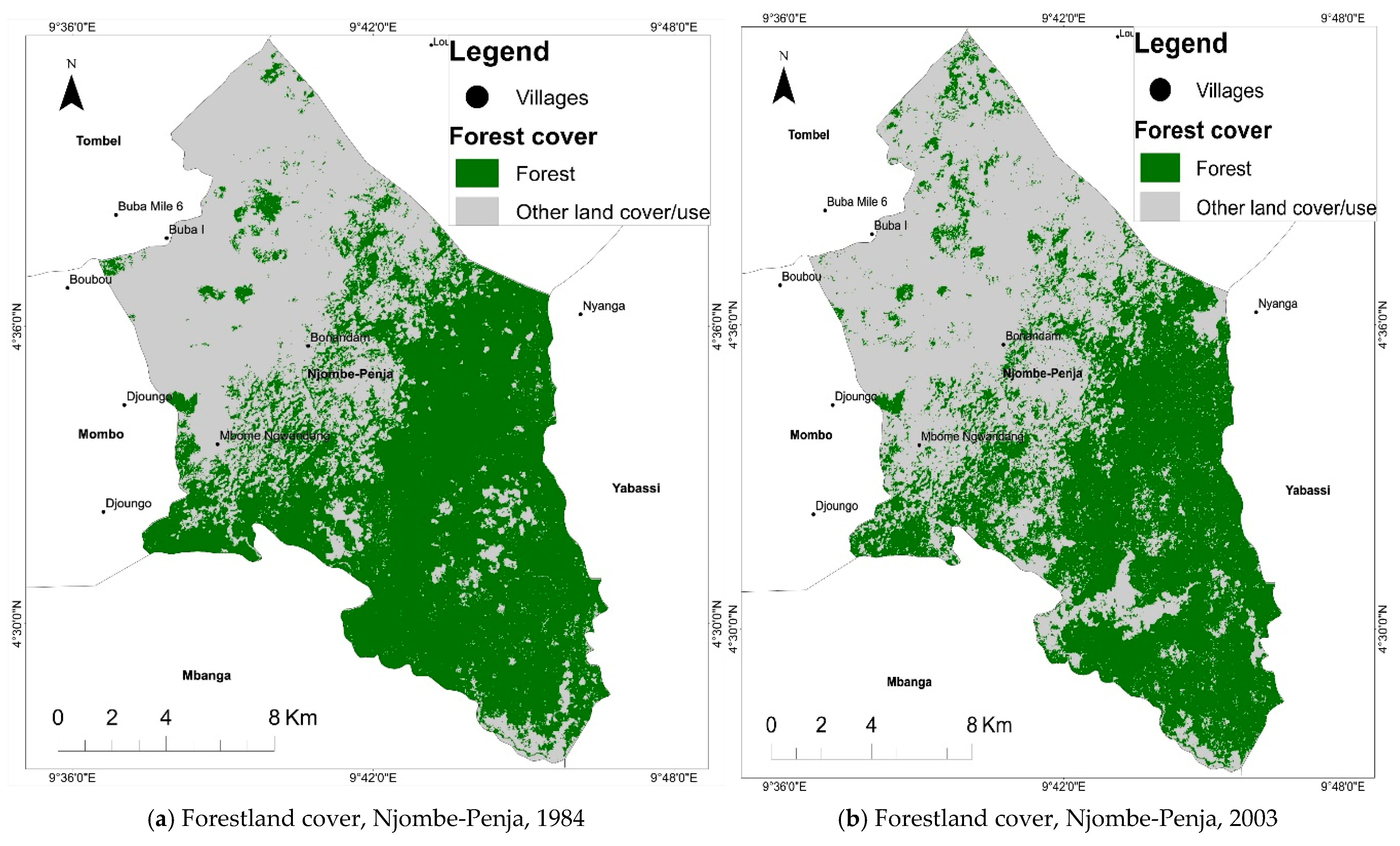
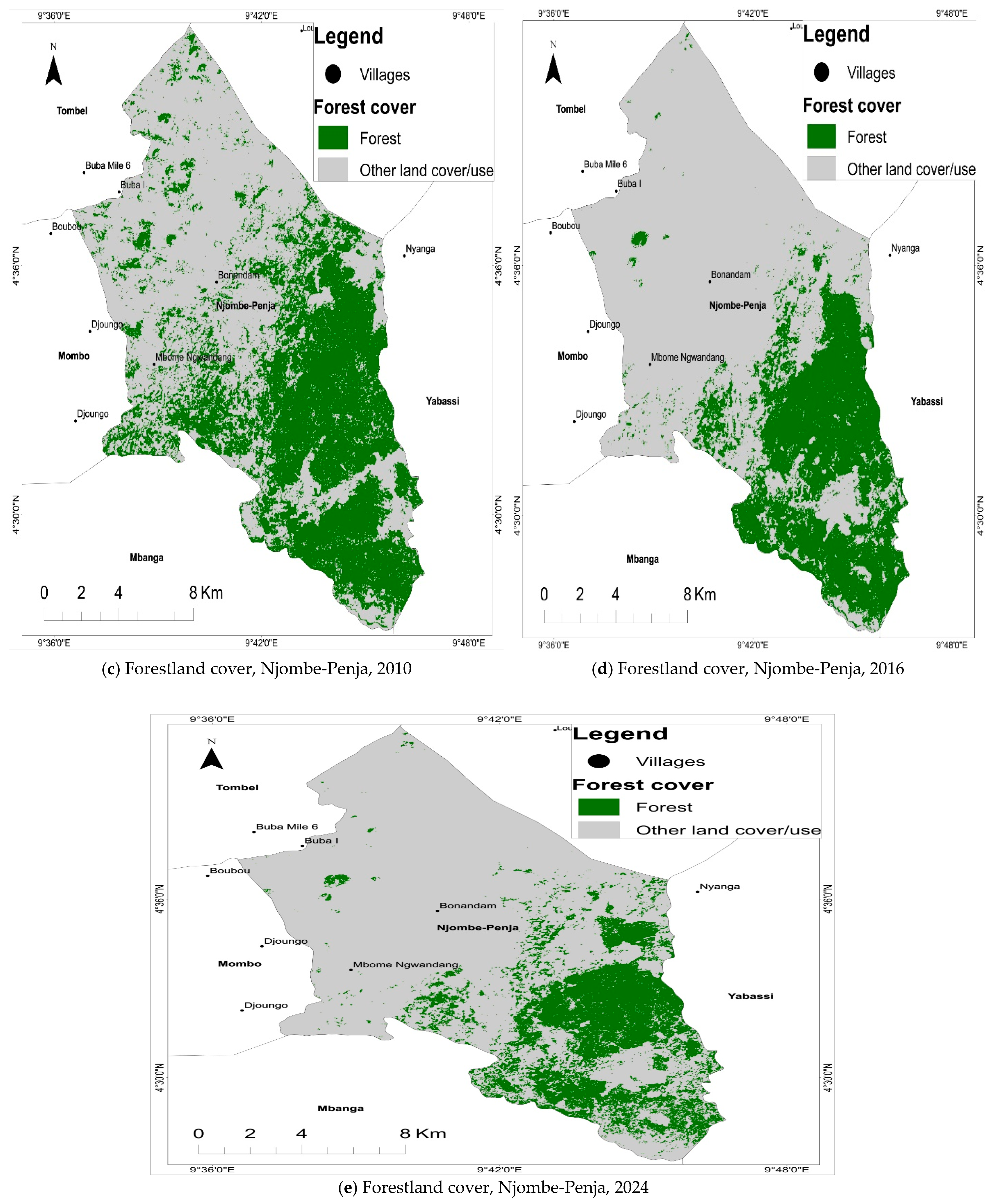
| Community | 2010–2015 | 2016–2024 | ||||||
|---|---|---|---|---|---|---|---|---|
| 1–3 Bags | 4–6 Bags | 7–9 Bags | 10+ Bags | 1–3 Bags | 4–6 Bags | 7–9 Bags | 10+ Bags | |
| Melong | 0% | 0% | 31.4% | 68.5% | 17.8% | 46.3% | 34.4% | 1.5% |
| Nlonako | 0% | 0% | 23.9% | 76.1% | 0% | 13.4% | 52% | 34.6% |
| Loum | 0% | 0% | 25.8% | 74.2% | 6.2% | 7.5% | 40.9% | 45.3% |
| Njombe-Penja | 0% | 0% | 28% | 72% | 0% | 0% | 44% | 56% |
| LCLU | 1984 | 2003 | 2010 | 2016 | 2024 | Percentage Change |
|---|---|---|---|---|---|---|
| Forest | 2664.92 | 2096.784 | 2118.042 | 1943.38 | 1857.393 | 69.69% |
| Cropland | 2858.814 | 3522.36 | 3459.03 | 3593.01 | 3663.71 | 128.15% |
| Grassland | 353.672 | 246.967 | 285.112 | 304.343 | 309.23 | 87.43% |
| Water bodies | 2.728 | 2.042 | 2.86 | 2.197 | 2.853 | 104.5% |
| Built-up | 61.938 | 73.92 | 77.023 | 99.144 | 108.883 | 175.8% |
| Total | 5942.07 | 5942.07 | 5942.07 | 5942.07 | 5942.07 | 565.57% |
| LCLU | 1984 | 2003 | 2010 | 2016 | 2024 | Percentage Change |
|---|---|---|---|---|---|---|
| Forest | 3472.26 | 3255.30 | 3294.279 | 2924.325 | 2999.799 | 86.39% |
| Cropland | 448.299 | 646.902 | 627.894 | 987.408 | 894.114 | 199.44% |
| Grassland | 26.955 | 33.957 | 10.029 | 17.379 | 17.049 | 63.24% |
| Built-up | 16.2 | 27.558 | 31.518 | 34.608 | 52.758 | 325.66% |
| Total | 3963.72 | 3963.72 | 3963.72 | 3963.72 | 3963.72 | 674.73% |
| LCLU | 1984 | 2003 | 2010 | 2016 | 2024 | Percentage Change |
|---|---|---|---|---|---|---|
| Forest | 1465.21 | 1445.06 | 1280.808 | 803.088 | 705.888 | 48.176% |
| Cropland | 1368.97 | 1382.66 | 1538.00 | 1994.25 | 2076.14 | 151.657% |
| Water bodies | 2.588 | 2.531 | 2.2 | 2.35 | 2.75 | 106.259% |
| Built-up | 26.46 | 32.985 | 42.228 | 63.549 | 78.455 | 296.504% |
| Total | 2863.23 | 2863.23 | 2863.233 | 2863.233 | 2863.233 | 602.596 |
| LCLU | 1984 | 2003 | 2010 | 2016 | 2024 | Percentage Change |
|---|---|---|---|---|---|---|
| Forest | 1556.60 | 1475.65 | 1100.826 | 760.374 | 548.181 | 35.216% |
| Cropland | 1055.18 | 1127.95 | 1480.70 | 1814.65 | 2022.45 | 191.668% |
| Built-up | 26.244 | 34.417 | 56.496 | 62.999 | 67.39 | 256.668% |
| Total | 2638.02 | 2638.02 | 2638.02 | 2638.02 | 2638.02 | 483.552% |
Disclaimer/Publisher’s Note: The statements, opinions and data contained in all publications are solely those of the individual author(s) and contributor(s) and not of MDPI and/or the editor(s). MDPI and/or the editor(s) disclaim responsibility for any injury to people or property resulting from any ideas, methods, instructions or products referred to in the content. |
© 2025 by the authors. Licensee MDPI, Basel, Switzerland. This article is an open access article distributed under the terms and conditions of the Creative Commons Attribution (CC BY) license (https://creativecommons.org/licenses/by/4.0/).
Share and Cite
Abam, C.E.; Kimengsi, J.N.; Fogwe, Z.N. Forestland Resource Dynamics in Hollow Frontiers of Sub-Saharan Africa: Empirical Insights from the Mungo Corridor of Cameroon. Earth 2025, 6, 140. https://doi.org/10.3390/earth6040140
Abam CE, Kimengsi JN, Fogwe ZN. Forestland Resource Dynamics in Hollow Frontiers of Sub-Saharan Africa: Empirical Insights from the Mungo Corridor of Cameroon. Earth. 2025; 6(4):140. https://doi.org/10.3390/earth6040140
Chicago/Turabian StyleAbam, Chick Emil, Jude Ndzifon Kimengsi, and Zephania Nji Fogwe. 2025. "Forestland Resource Dynamics in Hollow Frontiers of Sub-Saharan Africa: Empirical Insights from the Mungo Corridor of Cameroon" Earth 6, no. 4: 140. https://doi.org/10.3390/earth6040140
APA StyleAbam, C. E., Kimengsi, J. N., & Fogwe, Z. N. (2025). Forestland Resource Dynamics in Hollow Frontiers of Sub-Saharan Africa: Empirical Insights from the Mungo Corridor of Cameroon. Earth, 6(4), 140. https://doi.org/10.3390/earth6040140






